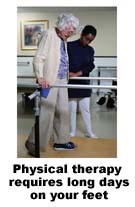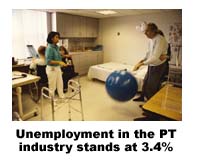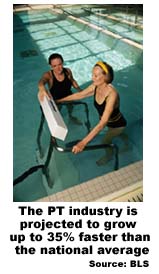|
'Working Your Degree'
|
 |
July 28, 2000: 7:51 a.m. ET
Physical therapists face stiff competition, but opportunities abound
By Staff Writer Shelly K. Schwartz
|
NEW YORK (CNNfn) - You spent six years and nearly $100,000 on a degree that positioned you for one of the "hottest fields" in an already flourishing job market -- physical therapy.
You knew going in that it wouldn't be easy. There would be rigorous entrance exams, science-heavy course loads and, once you graduated, the work itself would be demanding.
The least you expected was job security.
"It used to be a market where you were guaranteed a job and you could demand anything you wanted and get it because there was such a shortage of PTs," said Barb Bauman, a long-time physical therapist and owner of Bauman Physical Therapy in Lexington, Ky. "But because of managed care (and cutbacks in Medicare reimbursement levels), it's not as good as it had been."
Add to that the growing ranks of recent grads entering the labor pool and experts say PT professionals are experiencing one of the most competitive job markets they've seen in years.
"Physical therapists were in very high demand about 10 years ago, starting in the late 1980s, and then we saw more and more schools opening physical therapy programs and that meant more students coming out," said Alexis Waters, spokeswoman for the American Physical Therapy Association. "Starting in January 1999, we saw for the first time in years that physical therapists were in an unemployment situation."
The jobless rate for PTs currently stands at around 3.4 percent, lower than the 4 percent national average, but still one of the highest the industry has seen in its 78-year history.
Industry insiders, though, say those pursuing a career in physical therapy -  including those already in it - should not despair. Despite the recent, downturn, they say, opportunities in the field remain strong. And, they note, there are several creative new ways to put your PT degree to work for you. including those already in it - should not despair. Despite the recent, downturn, they say, opportunities in the field remain strong. And, they note, there are several creative new ways to put your PT degree to work for you.
"I think it's stabilizing after the big hit it took from budget cuts (on Capital Hill)," said Bauman, who specializes in women's health services. "You just have to look a little harder and stay flexible. You may have to relocate or work in a more rural setting. And chances are you won't find that perfect job right away. But the opportunities are still out there."
Visit CNNfn's Career page regularly to read "Working your Degree," a new column which highlights a different college major and offers advice on traditional and unique job opportunities. Click here for last week's profile of the computer science job market.
Where the industry stands now
Physical therapists, by definition, are health care professionals who evaluate and treat people with health problems resulting from injury or disease, according to APTA.
They assess joint motion, muscle strength and endurance, function of heart and lungs, and performance of activities required in daily living.
At present, the minimum educational requirement for becoming a PT professional is a four-year college degree in physical therapy from an accredited education program. APTA, however, notes the majority of programs these days offer the master's degree in physical therapy and after 2002, post-baccalaureate degrees will be required.
To give you a sense of cost, those who enroll in a two- or three-year master's degree PT program at a private university pay roughly $50,500 in tuition and fees, not including room and board. Their more dollar-conscious counterparts pay closer to $18,000 for the program at a public school.
That's on top of the cash shelled out for an undergraduate degree, which can range from $5,000 per year for an in-state school to $50,000 or more for a high-caliber private institution.
 The PT profession remains highly female-oriented. Today, some 86 percent are women, according to the College Majors Handbook. The PT profession remains highly female-oriented. Today, some 86 percent are women, according to the College Majors Handbook.
 According to APTA, the average annual salary for those in the industry is $56,500. That's in-line with other industry data revealing 45 percent of PTs earn between $45,000 and $70,000. But some, depending on their geographic location, have the potential to earn more than $100,000. According to APTA, the average annual salary for those in the industry is $56,500. That's in-line with other industry data revealing 45 percent of PTs earn between $45,000 and $70,000. But some, depending on their geographic location, have the potential to earn more than $100,000.
"We may have some unemployment in this field, but it's still far less than the general public and we still have the opportunity to make a good salary," said Andrew Guccione, a senior vice president for APTA and a physical therapist of 22 years. "This isn't the place to become incredibly wealthy. You won't necessarily have a large 6-figure salary, but you'll be doing something that really helps people and you'll earn a solid middle-class living."
The trio effect
The long-time shortage of professional PTs in the labor market began to shift about a decade ago, when colleges and universities starting adding physical therapy programs to their roster of degree offerings. Today, 173 schools nationwide offer such programs.
 Also about 10 years ago, health maintenance organizations and other insurance providers emerged as a force to be reckoned with, demanding more from their physicians for less and cutting back on reimbursement levels for PT services. Also about 10 years ago, health maintenance organizations and other insurance providers emerged as a force to be reckoned with, demanding more from their physicians for less and cutting back on reimbursement levels for PT services.
The third nail in the coffin was Uncle Sam. In 1997, President Clinton passed Balanced Budget Act (BBA), which dramatically reshaped the health safety net for America's needy. It also, however, curbed significantly any coverage for physical therapy services among Medicare recipients when it took effect in January 1999.
"We are experiencing our own version of the 'perfect storm,'" Guccione, of APTA, said. "It really probably has capsized a lot of PT boats floating out there."
There may be light at the end of the tunnel, however.
Beginning early this year, Congress placed a moratorium on the BBA's impact on Medicare cutbacks. Studies are underway to determine whether there is another, better way to bring back physical therapy services for Medicare recipients at a reasonable price to taxpayers. The study will be completed in about two years and until then, Medicare recipients are free to utilize PT services.
"We are hearing of people going back to work who were unemployed for awhile and we are seeing (supply vs. demand) leveling off," Guccione said.
In the field
Government data reveal physical therapists held about 120,000 jobs in 1998, the most recent year for which information is available. But the data don't tell the whole story.
The number of jobs, BLS reports, is greater than the number of practicing physical therapists because many of them hold two or more jobs. Many in private practice, for example, work part-time in another health facility
The vast majority (more than 75 percent) are employed in either acute-care or sub-acute hospitals or physical therapists offices. Others work in home health agencies, outpatient rehabilitation centers, offices and clinics of physicians, and nursing homes.
And some, like Bauman, are self-employed - either running their own offices or contracting with hospitals, rehab centers and adult daycare programs to provide services on a case-by-case basis.
"We are seeing the re-emergence of small independent private practices with one or two-person offices," Guccione said. "It's almost a return to a previous economic model, only now many PTs are specializing in niche markets."
Those niche markets include specialties in women's health issues, consulting and wellness care, which provide preventive care and muscle strengthening exercises for older Americans looking to stay healthy.
"What better person to work in a wellness facility than someone with a physical therapy background; someone with the education to know how your body works and to give you direction for prevention," Waters said. "There are many other opportunities to consult too, especially for all those businesses out there looking to create ergonomic work stations."
(Visit CNNfn's Career page and scroll to the bottom for our salary sample - a list of average annual salaries broken down by occupation and city.)
According to the BLS, the PT industry itself is projected to grow up to 35 percent faster than the national average between now and 2008.
 BLS's occupational outlook study reveals Medicare legislation "may continue to adversely affect the job market for physical therapists in the near term." But it suggests the "majority of expected employment growth for physical therapists will occur" between 2004 and 2008, as the population needing PT services the most continues to age. BLS's occupational outlook study reveals Medicare legislation "may continue to adversely affect the job market for physical therapists in the near term." But it suggests the "majority of expected employment growth for physical therapists will occur" between 2004 and 2008, as the population needing PT services the most continues to age.
The baby boom generation, in particular, will find themselves in greater need of rehabilitative services as medical technology lengthens the average lifespan heart attacks and strokes become more prevalent. At the same time, demand for PTs will remain strong for newborns with severe birth defects and those injured in accidents.
Job requirements
According to the BLS, anyone considering a PT career should have strong interpersonal skills to successfully educate patients about their physical therapy treatments. They also "should be compassionate and possess a desire to help patients. Similar traits are also needed to interact with the patient's family."
Bauman also warns you'd better get comfortable shoes. The job is physically demanding, since PTs stoop, kneel, crouch and lift heavy equipment all day long. That says nothing of the time you'll spend on your feet.
"All my work is manual, so if I'm trying to strengthen a particular muscle or move it in a specific pattern I have to physically challenge a person's body," she said, noting you should also be a good motivator for your patients. "That often requires me resisting a certain extremity or movement pattern."
The road less traveled
Bauman's parting words of wisdom for those looking toward a PT career?
"Stay flexible and be creative," she said. "Try to isolate a specialty area because that will make you far more sellable." 
|
|
|
|
|
 |

|

